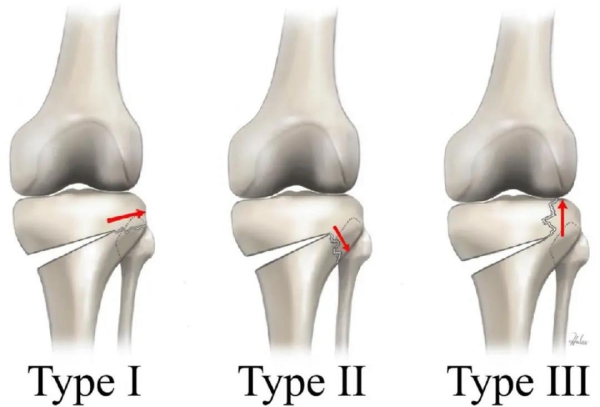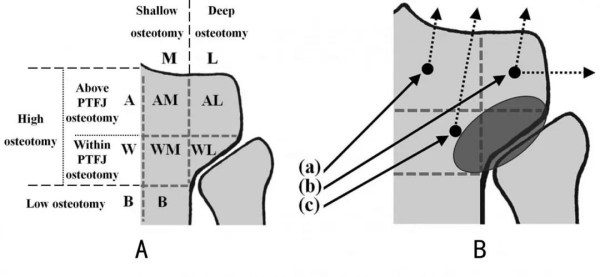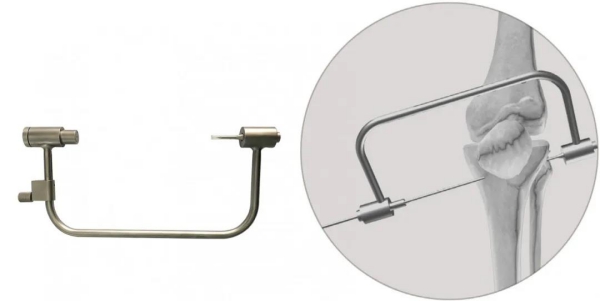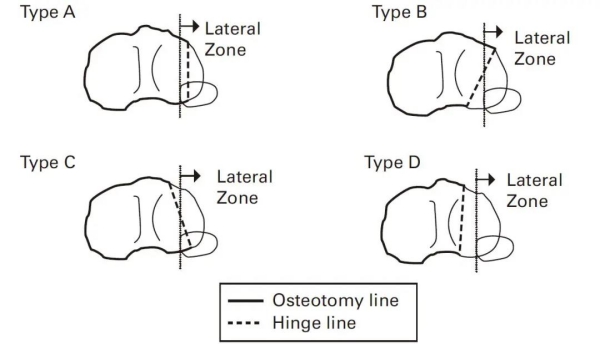Contralateral hinge fractures are likely to occur during and after osteotomy around the knee joint (especially for medial open wedge osteotomy).
The contralateral hinge fracture can reduce the axial stiffness of this area of the tibia by 58% and torsional stiffness by 68%. At the same time, the micromotion of the osteotomy site increases, which may cause displacement, instability of the osteotomy area, and recurrent varus. Malformation makes it impossible to correct.
How to prevent contralateral hinge fractures has become a hot issue. The following research points are worthy of attention.

Nakamura et al. found that there was no significant difference in the height of distraction between type I fractures and type II and III fractures, indicating that the severity of the fracture was not proportional to the height.
Research on osteotomy positions found:
Osteotomy height: Osteotomy in zone B (The figure below) may have the risk of type II fractures. Therefore, the high osteotomy is safer than low osteotomy;

Osteotomy depth: the incidence of type III fractures in the M area is significantly higher than that of the L area type III fractures;
Therefore, osteotomy in the structurally stable WL area will avoid fracture to a certain extent (relative risk is 0.24, confidence interval 0.17 ~ 0.34);
The dense and firm soft tissue near the proximal tibiofibular joint (PTFJ) is one of the reasons for the relative stability of this area.

-Adequacy of osteotomy-
Studies have shown that the incidence of lateral hinge fractures has a significant statistical correlation with inadequate osteotomy:
All type III lateral hinge fractures occurred under osteotomy (type C, n = 3);
Type I lateral hinge fractures occur when osteotomy is adequate (type A, n = 7) and inadequate (type B, n = 3; type C, n = 1).
Therefore, sufficient anterior and posterior osteotomy can be performed (The image below shows A type osteotomy), or the incidence of type III fractures can be reduced.

-Distraction height of osteotomy-
Seo et al. reported that a medial expansion distance greater than 11mm is a significant risk factor for lateral hinge fractures (OR = 4.98). The risk of lateral hinge fracture after MOWHTO with a larger osteotomy gap is as high as 35%.
Therefore, when the size of the medial distraction increases, more attention should be paid to the lateral cortex. Slowly and cautiously increasing the osteotomy gap can help avoid lateral hinge fractures.
-The choice of cortical screws-
While the force exerted by the cortical screw on the bone affects the shape of the plate, it can pressurize the side hinge, eliminate any potential distraction or instability in the area, and reduce the incidence of type I fractures.
The above information is provided by knee joint preservation manufacturer.
Copyright:@2020-2021
Comments Please sign in or sign up to post.
0
0 of 500 characters used